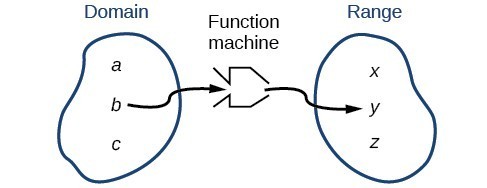- Determine the set of all possible input values for a function based on its equation
- Identify the set of all possible inputs (domain) and outputs (range) from looking at a graph
- Figure out the allowed inputs and outputs for the fundamental toolkit functions
- Sketch piecewise functions, showing each segment with its own rule on the graph
Domain and Range
Now that we understand what functions are, let’s talk about two important concepts related to them: the domain and the range.
We can visualize the domain as a “holding area” that contains “raw materials” for a “function machine” and the range as another “holding area” for the machine’s products.

Domain and Range
Domain: The domain of a function is the set of all possible input values. These are the values that you can put into the function.
- Note that values in the domain are also known as input values, or values of the independent variable, and are often labeled with the lowercase letter [latex]x[/latex].
Range: The range of a function is the set of all possible output values. These are the values that come out of the function.
- Values in the range are also known as output values, or values of the dependent variable, and are often labeled with the lowercase letter [latex]y[/latex].
We can write the domain and range in interval notation, which uses values within brackets to describe a set of numbers. In interval notation, we use a square bracket [latex][[/latex] when the set includes the endpoint and a parenthesis [latex]([/latex] to indicate that the endpoint is either not included or the interval is unbounded. For example, if a person has [latex]$100[/latex] to spend, he or she would need to express the interval that is more than [latex]0[/latex] and less than or equal to [latex]100[/latex] and write [latex]\left(0,\text{ }100\right][/latex].
- The smallest term from the interval is written first.
- The largest term in the interval is written second, following a comma.
- Parentheses, ( or ), are used to signify that an endpoint is not included, called exclusive.
- Brackets, [ or ], are used to indicate that an endpoint is included, called inclusive.
Understanding the domain and range helps us to see the full scope of a function and how it operates over different values.
| Family Member’s Name (Input) | Family Member’s Age (Output) |
|---|---|
| Nellie | [latex]13[/latex] |
| Marcos | [latex]11[/latex] |
| Esther | [latex]46[/latex] |
| Samuel | [latex]47[/latex] |
| Nina | [latex]47[/latex] |
| Paul | [latex]47[/latex] |
| Katrina | [latex]21[/latex] |
| Andrew | [latex]16[/latex] |
| Maria | [latex]13[/latex] |
| Ana | [latex]81[/latex] |
Domain: The domain is the set of all family members’ names:
Range: The range is the set of all family members’ ages: [latex]\{13,11,46,47,21,16,81\}[/latex]
Relations can be written as ordered pairs of numbers [latex](x,y)[/latex] or as numbers in a table of values the columns of which each contain inputs or outputs. By examining the inputs ([latex]x[/latex]-coordinates) and outputs ([latex]y[/latex]-coordinates), you can determine whether or not the relation is a function. Remember, in a function, each input corresponds to only one output. That is, each [latex]x[/latex] value corresponds to exactly one [latex]y[/latex] value.